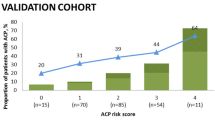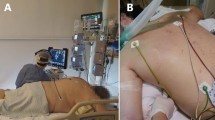Access this chapter
Tax calculation will be finalised at checkout
Purchases are for personal use only
Similar content being viewed by others
Suggested Readings
Jardin F, Vieillard-Baron A. Is there a safe plateau pressure in ARDS? The right heart only knows. Intensive Care Med. 2007;33:444–7.
Mekontso-Dessap A, Boissier F, Charron C, et al. Acute cor pulmonale during protective ventilation for acute respiratory distress syndrome: prevalence, predictors, and clinical impact. Intensive Care Med. 2016;42:862–70.
Paternot A, Repessé X, Vieillard-Baron A. Rationale and description of right ventricle-protective ventilation in ARDS. Respir Care. 2016;61:1391–6.
Price L, McAuley D, Marino P, Finney S, Griffiths M, Wort S. Pathophysiology of pulmonary hypertension in acute lung injury. Am J Physiol Lung Cell Mol Physiol. 2012;302(9):L803–15.
Vieillard-Baron A, Charron C, Caille V, et al. Prone position unloads the right ventricle in severe ARDS. Chest. 2007;132:1440–6.
Author information
Authors and Affiliations
Corresponding author
Editor information
Editors and Affiliations
Multiple Choice Questions
Multiple Choice Questions
-
1. Among the following parameters, which ones have been strictly proven to be at risk of RV failure?
-
A.
Hyperoxia.
-
B.
Hypocapnia.
-
C.
High PEEP.
-
D.
High plateau pressure (>26 cmH2O).
-
E.
Hypercapnia.
-
A.
-
Answers: D, E
-
2. What has been proven (clinically or experimentally) to control the deleterious effect of hypercapnia on RV function?
-
A.
VA ECMO.
-
B.
VV ECMO.
-
C.
High respiratory rate.
-
D.
Prone position.
-
E.
Extracorporeal CO2 removal (ECCO2R).
-
A.
-
Answers: A, D, E
-
3. A right ventricular protective approach would:
-
A.
Systematically apply a high PEEP.
-
B.
Limit the driving pressure.
-
C.
Decrease the FiO2.
-
D.
Largely use proning.
-
E.
Limit the level of hypercapnia.
-
A.
-
Answers: B, D, E
Rights and permissions
Copyright information
© 2020 Springer Nature Switzerland AG
About this chapter
Cite this chapter
Vieillard-Baron, A. (2020). Echocardiography in ARDS. In: Slama, M. (eds) Echocardiography in ICU. Springer, Cham. https://doi.org/10.1007/978-3-030-32219-9_20
Download citation
DOI: https://doi.org/10.1007/978-3-030-32219-9_20
Published:
Publisher Name: Springer, Cham
Print ISBN: 978-3-030-32218-2
Online ISBN: 978-3-030-32219-9
eBook Packages: MedicineMedicine (R0)




